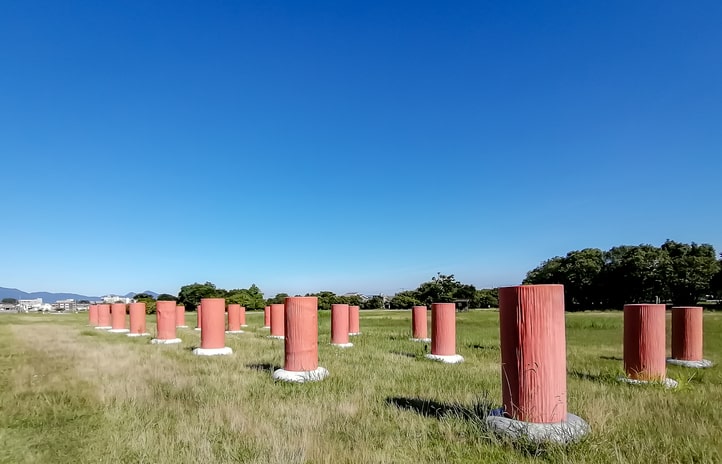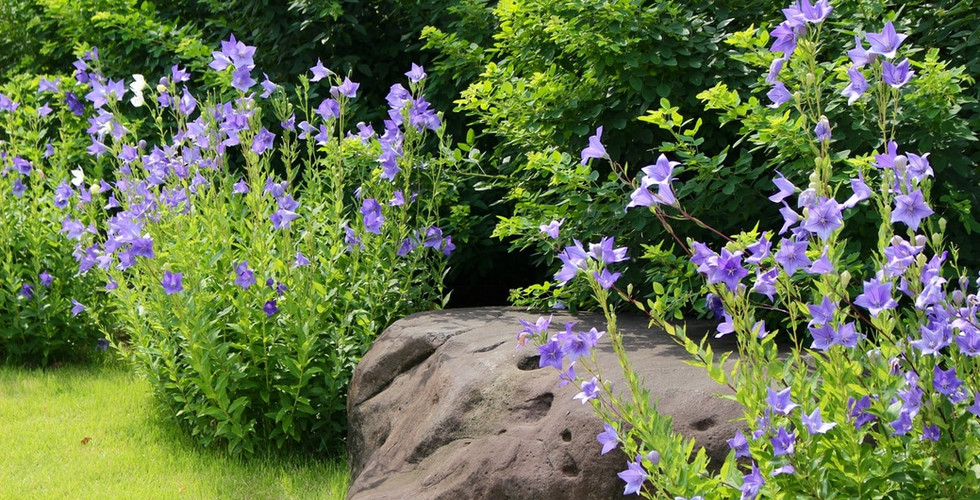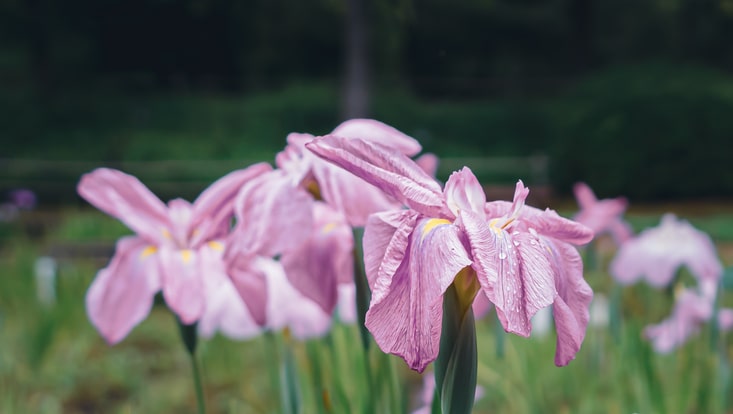Summer Flowers in Nara Prefecture
- NARA Visitor Center & Inn

- Oct 14, 2023
- 11 min read
Updated: May 9, 2024
Nara Prefecture is renowned for its abundant natural beauty and deep reverence for the environment. The people of Nara take immense pride in their lush landscapes, making every effort to preserve and cherish their rich flora. Flowers hold a special place in Nara's culture, as they are not only admired for their beauty but also carry significant cultural meanings, often marking the changing seasons and used to celebrate various events throughout the year.

We hope you enjoy the pictures in Summer Flowers in Nara Prefecture and that they inspire you to visit some of these places next time you're in Nara.
Lotus
Blooming time: Mid-June to mid-August

The lotus holds immense significance in Japanese Buddhism, where it serves as a powerful symbol of spiritual enlightenment and purity. It is prominently featured in various aspects of Buddhist culture, including art, architecture, and rituals. Many grand Buddhist statues, such as the renowned Big Buddha of Todai-ji Temple, often incorporate the lotus motif, signifying the importance of this iconic flower in the Buddhist tradition.
The Lotus Road
The Nara Lotus Road is a mesmerizing journey through Nara City that unveils the enchanting beauty of lotus flowers at four remarkable temples: Saidai-ji, Kiko-ji, Toshodai-ji, and Yakushi-ji. The Lotus Road is unsurprisingly a popular beat for photographers, but also offers a delightful contrast to conventional hiking trails, as it weaves through Nara City's suburban landscape, presenting a refreshing alternative to the more typical mountainous routes. The Lotus Road provides a perfect blend of suburban Japan, natural beauty and historical significance.
For a more detailed article on The Nara Lotus Road, click here
Fujiwara-kyo Ruins
Nestled among the three sacred mountains of Unebiyama, Kaguyama, and Miminashiyama lies Fujiwara-kyo, an ancient capital founded 1,300 years ago and Japan's first capital built in a grid pattern on the Chinese model.
Recent excavations have revealed that the city covered an area of roughly 5 km surrounded by walls roughly 5 m high. All that remains today is a lush landscape, a vestigial mound that once cradled the Imperial Audience Hall, and vermillion pillars that silently narrate its grand history.
Fujiwara-kyo Ruins harmoniously blends history and nature. The fields come alive with cherry blossoms in the spring, lotus flowers in the summer and cosmos flowers in the autumn, making Fujiwara-kyo Ruins popular with photographers, families and history aficionados alike.
Address: Daigocho, Kashihara, Nara 634-0072
Tel: 0744-21-1115
Hours: 24hrs
Admission: Free
Hydrangea
Blooming time: Late May to early July

When the rainy season arrives in Nara, it brings forth a breathtaking array of hydrangeas, transforming the landscape into a mesmerizing sea of blues, purples, and pinks.
With roots reaching back to the 8th century in Japanese annals and later introductions of European varieties during the 20th century, hydrangeas have become a timeless symbol of the Japanese rainy season and the beginning of summer. Due to their voluminous blooms and pretty hues, hydrangeas are a perennial favorite and in recent years, more and more temples have been utilizing hydrangeas to decorate their gardens in an attempt to entice more tourists and photographers to their grounds.
Yata-dera Temple
Atop Koriyama town, Yatadera Temple tells a tale of antiquity, its inception dating back to 679 when Emperor Tenmu sought refuge amidst civil unrest, his fervent prayers echoing through time. Easily reached by bus from Yamato Koriyama station, Yatadera unveils a captivating world during June and July, as 10,000 hydrangea bushes burst forth in resplendent bloom.
Climbing the stairways adorned with Jizo statues, visitors are greeted by a stone avenue, once home to monks and now offering tea, vegetarian meals, and even sutra copying experiences. The temple's main hall, adorned with a graceful wooden belfry, stands as a testament to history, Kobo Daishi's revered presence gracing these grounds. As you wander through the gardens, you tread a path carved by this renowned monk, a condensed echo of the famed 88-temple Kobo Daishi pilgrimage of Shikoku. From June 1st to July 10th, Yatadera Temple's garden blooms into a captivating sea of hydrangeas, painting a mesmerizing portrait of nature's beauty.
Address: 3506 Yatacho, Yamatokoriyama, Nara 639-1058, Japan
Tel: 0743531445
Hours: 8:30 - 17:00
Admission: ¥700 | Elementary School Students ¥300 during the hydrangea season (May – Jul)
Oka-dera Temple
Established in 663, Ryugai-ji Temple, or Oka-dera, derives its origins from an enthralling legend. A resolute Buddhist monk named Gien confronted a menacing dragon, ultimately imprisoning it beneath a serene pond using a hefty stone known as a “ryugai” or dragon lid.
Japanese lore attributes mystical powers to dragons' tail spheres, believed to grant wishes. At Oka-dera, visitors can purchase unique “Ryutama” or dragonballs made of wood. After inscribing your wish on a delicate scroll within, you then hang the dragon ball at one of the designated areas just in front of the main hall for your wish to come true.
Oka-dera Temple has become famous in recent years for its beautiful display of seasonal flowers and during hydrangea season, the temple monks work hard to adorn the grounds with hundreds of pots of colorful hydrangeas.
You can read more about the temple here.
Address: 806 Oka, Asuka, Takaichi District, Nara 634-0111, Japan
Tel: 0744-54-2007
Hours: 8:30 - 17:00
Admission: ¥400 | High School Students ¥300 | Junior High School Students ¥200
Hase-dera Temple
Quite simply, Hase-dera Temple is a beautiful temple that usually flies under the radar of overseas tourists due to its location, some 40 minutes south of Nara City.

Founded in 686 as a dedication to the then Emperor Tenmu who was suffering from a disease, the temple is cradled in a picturesque valley and boasts a collection of over 30 structures. The vast grounds are decorated with an array of seasonal flowers, so much so that barely a day goes by when the temple is not frequented by pilgrims and photographers eager to take in the many breathtaking vistas that the temple offers.
The list of blooms is quite considerable, but highlights are likely to be the cherry blossoms from the end of March through early April, and the Chinese peonies of late May. Then the magnificent hydrangea displays, rhododendrons and azaleas which herald the onset of summer. Once the heat arrives, the oleander and crape myrtle take center stage. Come autumn, the grounds are filled with vibrant reds, oranges and yellows, which finally make way for winter peonies and eventually plum blossoms, which signal the start of spring.
Address: 731-1 Hase, Sakurai, Nara, 633-0112
Tel: 0744-477-001
Hours:
April to Sept 8:30-17:00
Oct, Nov, March 9:00-17:00
Dec to Feb 9:00-16:30
Admission: ¥500 | Elementary School Students ¥250
Balloon Flower
Blooming Time: Mid-July to Late August

The delicate and enchanting balloon flower, scientifically known as Platycodon grandiflorus, is a captivating summer bloom cherished for its distinctive balloon-like buds that gradually unfurl into star-shaped blossoms with striking blue, violet, and white petals. Native to East Asia, it has a rich history of medicinal and culinary uses and has found its way into various cultural contexts, often symbolizing hope, growth, and transformation.
Gango-ji Temple
Gangō-ji Temple is a UNESCO World Heritage Site and is considered Japan's first official Buddhist Temple. Once counted among the illustrious Seven Great Temples, the vast temple grounds covered the area which is now modern-day Naramachi. Originally established as Asuka-dera by Soga no Umako during the Asuka period, the temple migrated to its current location 718, mirroring the capital's shift to Heijō-kyō.
Address: 11 Chuincho, 11, Nara, 630-8392
Tel: 0742-23-1377
Hours: 9:00 – 17:00
Closed: Wednesday, January 1st
Admission: ¥500 | Elementary School Students ¥200
Enjo-ji Temple
Enjō-ji is said to have been founded in 756 by a Chinese priest who accompanied Ganjin to Japan. The term "Enjo" in Enjoji refers to one of the six perfections (paramitas) that a bodhisattva should cultivate: the perfection of patience. It signifies the endurance and forbearance of all forms of physical and mental suffering.
The first thing you'll notice at Enjo-ji Temple is the beautiful garden that spreads out in front of the main gate. It is believed to have been created during the late Heian period and is a rare and valuable example of a pure land-style garden. In 1973, the garden was designated as a Place of Scenic Beauty.
Address: 1273 Ninnikusencho, Nara, 630-1244
Tel: 0742930353
Hours: 9:00 - 17:00
Admission:
Bush Clover
Blooming Time: August - September

As summer nears its end, the vibrant hues of bush clover add a final burst of color to Nara's landscape. The bush clover is mentioned in the Manyoshu, first great collection of Japanese poetry compiled in the late 8th century. It appears in 140 different poems, more than any other plant.
Toshodai-ji Temple
Toshodai-ji Temple, located on the outskirts of the city, was once a central part of Japan's capital over a millennium ago. Founded in 759, it earned its name from the Chinese origin of its first abbot, Ganjin, who established it as a center for Buddhist training. This temple became the first in Japan dedicated to the Nanzan school of Chinese Buddhist teachings, and it remains the head temple of Japan's Ritsu-shu denomination.
Interestingly, the temple's lecture hall (kodo) was originally an administrative building located at Heijyo-kyu (Nara Imperial Palace). The court gifted it to Ganjin, wherein it was relocated to its present site. Today, it is the only surviving building of the former palace and thus an important National Treasure.
Address: 13-46 Gojo-cho, Nara, 630-8032
Hours: 8:30 – 17:00
Fee: ¥1,000
Yamato Bunkakan
The establishment and construction of the Yamato Culture and Art Museum (Yamato Bunkakan) was one of the first efforts to re-establishing Japan’s national culture after the ravages of World War II. The President of the Kintetsu Railway Company, Oita Torao, collaborated with art historian Yashiro Yukio to collect around 2,000 artworks from Japan, China and Korea.
The museum sits atop of a small hill which is accessed via a small wooded area, carefully curated to display an array of seasonal flowers.
Address: 1-chōme-11-6 Gakuenminami, Nara, 631-0034
Tel: 0742-45-0544
Hours: 10:00 - 17:00
Closed: Monday
Fee: Adults ¥630, High school and college students ¥420, Elementary and junior high school students Free
Special exhibitions
Adults ¥950 | High school and college students ¥730 | Elementary and junior high school students Free
Water Lily
Blooming time: Late June to mid-July

In Nara's enchanting water gardens, water lilies reign supreme, captivating visitors with their ethereal beauty. Temples with ponds, traditional Japanese gardens and parks up and down the country are decorated with these gorgeous flowers and wide green leaves, each a real-life Monet masterpiece.
Isuien Garden
Isuien Garden near Todai-ji Temple, is an exquisitely preserved Japanese garden dating back to the Meiji era. Its name, "garden founded on water," reflects its serene ponds fed by the Yoshikigawa River. Split into two realms—the front dating to the 17th century and the rear added in 1899 - Isuien seamlessly blends nature and architectural elegance over an area covering 13,500 m2.
It captures borrowed scenery from Todaiji Temple's Nandaimon Gate and Mount Wakakusa, embodying a narrative of longevity through sculptures like the crane and tortoise. The shakkei technique artfully merges surrounding landscapes. Amidst pagodas and tea houses, Isuien beckons you to explore its cultural treasures at the Neiraku Museum.
Address: 74 Suimoncho, Nara, 630-8208, Japan
Tel: 0742-25-0781
Hours: 9:30 - 16:30
Closed: Tuesday
Admission: ¥1,200 | Uni & High School Students ¥500 | Junior High School Students ¥300
Hoki-ji Temple
Hoki-ji Temple was established in 708 by Prince Yamashiro, fulfilling his father Shotoku Taishi's final wish. Originally, the site housed the Okamoto Palace, where Shotoku Taishi imparted teachings on the Lotus Sutra. Flourishing in the Nara period, the temple later declined, finding kinship under Horyu-ji Temple's jurisdiction, its sole original remnant being the revered three-storied pagoda, now a National Treasure.
This imposing pagoda, the nation's oldest three-storied pagoda, rises 24 meters tall, serves as a poignant relic of Japan's Asuka period, its design mirrored Horyu-ji Temple's Five-storied.
In December of 1993, Hoki-ji Temple was included in Horyu-ji Temple's selection as the first treasure of any kind in Japan to become a UNESCO World Heritage Site.
Address: 1873 Okamoto, Ikaruga, Ikoma District, Nara 636-0102, Japan
Tel: 0745-75-5559
Hours:
Feb 22nd - Nov 3rd 8:30 - 17:00
Nov 4th - Feb 21st 8:30 - 16:30
Admission: Adults ¥300, Junior High and under ¥200
Iris
Blooming time:

Late May to early June as summer unfolds, the elegant iris flowers bloom, gracing Nara's gardens with their elegant beauty. The Japanese iris is know for its strikingly large petals and array of colors, from pure white to deep purples.
Nara Prefectural Museum of Folklore and Yamato Folklore Park
The Nara Prefectural Museum of Folklore was established in Yamatokōriyama, Nara Prefecture, Japan, back in 1974. It is situated at the base of the Yata Hills within the expansive 26.6-hectare Yamato Folk Park. This museum is dedicated to collecting, preserving, and showcasing various artifacts that provide insights into the daily life of Nara Prefecture during the Edo period through the early Shōwa era.
The museum's surroundings offer an open-air experience within the park, featuring fifteen Edo-period minka (countryside farmhouses) sourced from different parts of the prefecture. Notable among them is the Former Usui Family Residence. The park also has several seasonal gardens, open spaces and ponds and a hiking trail linking them all together.
Address: 545 Yatacho, Yamatokoriyama, Nara 639-1058, Japan
Phone: 0743-533-171
Hours: 9:00 - 17:00
Closed: Monday
Yellow Cosmos
Sulfur Cosmos or Yellow Cosmos: Average blooming time: Mid-July to early August

Fujiwara-kyo Ruins
With the arrival of summer, sulfur cosmos, also known as yellow cosmos, bloom extravagantly in a 2 fields adjacent Fujiwara-kyo Palace Ruins. The area is a little far from the nearest train station but the free carpark across the road means the area is constantly frequented during the season.
Fujiwara-kyo, Japan's first grid-pattern capital, served as the Imperial capital for 16 years, from 694 to 710, situated in Yamato Province (present-day Kashihara in Nara Prefecture). Recent excavations in 2006 unveiled that Fujiwara-kyo sprawled over approximately 5 square kilometers, far larger than previously believed. The palace, encompassing about 1 square kilometer, was enclosed by 5-meter-high walls.
In 710, the Imperial court shifted to the Heijo Palace in Nara, marking the beginning of the Nara period.
Address: Daigocho, Kashihara, Nara 634-0072
Tel: 0744-21-1115
Hours: 24hrs
Admission: Free
Sun Flower
Blooming Time: Mid-July to early August

As the summer sun graces Nara with its warm embrace, the sunflowers bloom in full splendor, painting the landscape with vibrant green and gold. In the 17th century, sunflowers found their way to Japan, greeted initially with lukewarm enthusiasm. In an era that celebrated delicate charm, the sunflower's grandeur and overwhelming size were perceived as excessive and flamboyant.
However, Japan's appreciation for the sunflower's began to grow after the introduction of Nakamura Tekisai's inaugural illustrated encyclopedia, Kinmo Zui, in 1666. Nakamura referred to the sunflower as a popular plant and this propelled its popularity among Japanese horticulturists, sparking the spread of the sunflower across the country.
Umami Kyuryo Park
Umami Kyuryo Park was established in 1984 to help protect the ancient kofun burial mounds in the area from encroaching urban development. More than a mere park, Umami Kyuro Park is a captivating tapestry of nature's changing hues, each season casting its own unique floral spell. The park is expertly manicured, a picture-perfect scene around each and every corner.
Stretching 3km east to west and 7km north to south, the park is a perfect place to spend the day, leisurely exploring the vast array of natural beauty on offer.
Address: 2202 Samita, Kawai, Kitakatsuragi District, Nara 636-0062
Tel: 0745-56-3851
Hours: 8:00 - 18:00
June - August: 8:00 - 19:00
Nov - Feb: 8:00 ^ 17:00
Admission: Free
The Natural Sunflower Field
In Tenri city there is a sunflower field with a lovely story behind it.
The "Sunflower Power Project" aims to repurpose abandoned farmland in the local area to create a new tourist attraction in Tenri City and promote intergenerational interaction among citizens through the process. In 2021, they used seeds from the "Fukushima Sunflower Foster Parent Project" by an NPO in Fukushima Prefecture, the project carries the intention to commemorate the 10th anniversary of the Great East Japan Earthquake and raise disaster preparedness awareness.
The local neighborhood association teamed up with Tenri University and with the help of gardening club from Tenri High School they have been able to turn unused farm land into this beautiful sunflower field.
Thanks for reading Summer Flowers in Nara Prefecture
Check out these other nature-related articles.
Author: NARA Visitor Center & Inn



























































































































































Comments